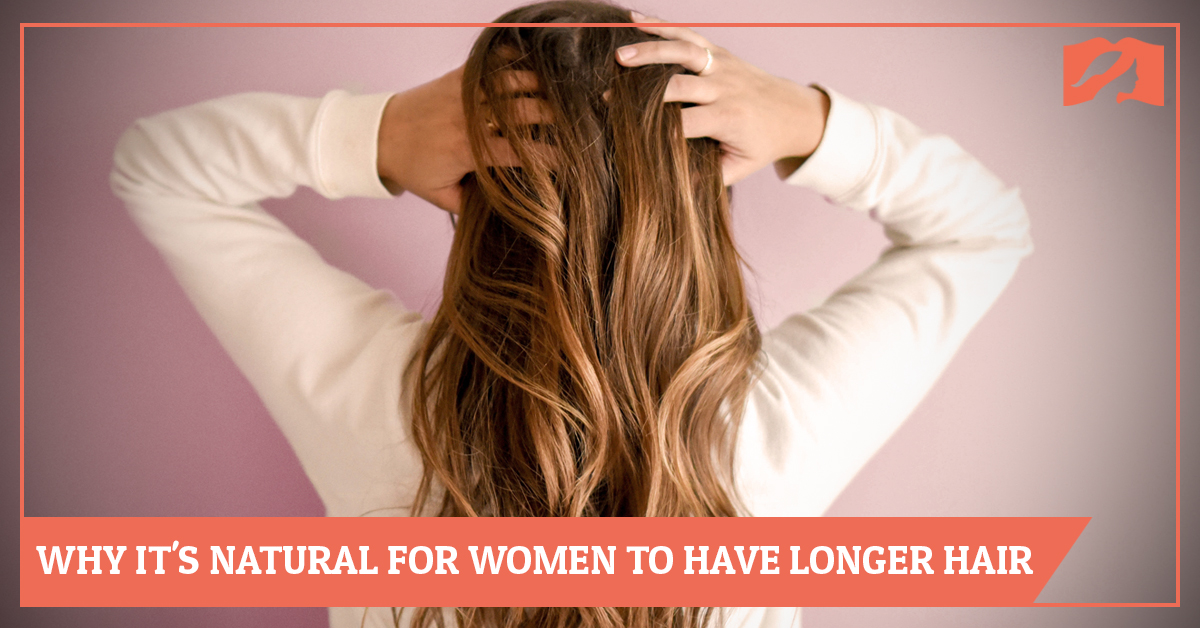The Biology of Hair Lengths: Why it’s Natural for Women to Have Longer Hair

Yes, there does seem to be a built-in biological process that causes women to have longer hair than men (generally speaking, of course). This process is due to our hormones. First, I need to explain how our hair grows. Men and women’s hair grow at pretty much the same rate of about 1cm per month. So the difference is not that women’s hair grows faster. 1) Castro, J. (2014). How Fast Does Hair Grow?. [online] Live Science. Available at: https://www.livescience.com/42868-how-fast-does-hair-grow.html [Accessed 12 Feb. 2018].
Our hair grows and sheds in a three-stage process which keeps repeating itself. So we keep cycling through the phases and each of the hairs on our head are in a different phase at any given time (with about 90% being in the growing phase). 2) Geggel, L. (2017). Hair Loss and Balding: Causes, Symptoms & Treatments. [online] Live Science. Available at: https://www.livescience.com/34731-hair-loss-alopecia-treatment.html [Accessed 12 Feb. 2018]. However, our hormones are a major factor which can determine how long we stay in a particular phase.
These three phases are:
Anagen – Hair growth phase (lasts 2-7 years)
Catagen – Transition phase (lasts about 10 days)
Telogen – Resting or shedding phase (lasts about 3 months)
I recommend you watch this short video to help you visualize and understand these three phases better:
As mentioned our hormones play a significant role in how long we stay in a particular phase. Obviously if one stays in the anagen (hair growth phase) for a longer time, they will have longer hair. And this is exactly the case: women tend to stay in this phase longer than men.
Pastor John MacArthur explains,
“Men and women have distinctive physiologies. One obvious difference is the process of hair growth. Head hair develops in three stages: formation and growth, resting, and fallout. The male hormone testosterone speeds up the cycle so that men reach the third stage earlier than women. The female hormone estrogen causes the cycle to remain in stage one for a longer period, causing women’s hair to grow longer than men’s.” 3) MacArthur, John (2011). Divine design. Colorado Springs: David C. Cook, p.49.
Now that is a theologian’s perspective, but is that backed up scientifically? Since dermatology is not a field I’m an expert in, I had to do some digging and I found out that MacArthur is absolutely correct in his assessment.
Here’s what some authorities specializing in hair biology say:
“The cause of pattern thinning in men is primarily related to two sex hormones, testosterone and DHT. The body converts testosterone into the hormone DHT by way of an enzyme found in various tissues throughout the body…In men…DHT increases the resting (telogen) phase and decreases the growing (anagen) phase of hair.” 4) Rassman, W. and Bernstein, R. (2009). Hair loss & replacement for dummies. Hoboken, NJ: John Wiley & Sons, p.61.
“DHT affects hair follicles and seems to prolong the telogen (resting) phase.” 5) Sherrow, V. (2006). Encyclopedia of hair. Westport, Conn. [u.a.]: Greenwood Press, p.173.
“In women, hair loss or noticeable thinning of the hair often occurs when levels of the female hormone estrogen decline after menopause. Prior to that time estrogen helps to counteract testosterone, which can be converted into the hormone DHT, which can cause hair follicles to…enter the resting stage of the hair growth cycle earlier than normal.” 6) Sherrow, V. (2006). Encyclopedia of hair. Westport, Conn. [u.a.]: Greenwood Press, p.173.
“There is some limited trichogram data to suggest that estrogens decrease the resting phase and prolong the growing phase of the hair cycle, hence estrogens are used in the treatment of female pattern hair loss in some countries.” 7) Thornton, J. and Stevenson, S. (2007). Effect of estrogens on skin aging and the potential role of SERMs. Clinical Interventions in Aging, Volume 2, pp.283-297.
In these sources, we see that the hormone DHT (Dihydrotestosterone) keeps a person in the resting/shedding phase longer and in the growing phase for a shorter period of time. While both genders can produce DHT, the female hormone estrogen counteracts testosterone (which is what gets converted to DHT). So that’s why DHT has more of effect on men unless a woman has low amounts of estrogen. We also see that estrogen decreases the resting phase and keeps a woman in the growing phase of the hair cycle for longer. When your hair is in the growing phase for longer, it obviously has more time to get longer.
So despite men and women’s hair growing at the same speed, there are natural biological functions which keep women’s hair growing longer than men’s. Of course, there will always be exceptions to the rule, but this is the normative pattern which shows God’s original design. After studying hair for over 30 years at an academic level, Dr. Kurt Stenn (author, Hair: A Human History) noted that “[It is] almost universally culturally found that women have longer hair than men.” 8) Fabry, M. (2016). Now You Know: How Did Long Hair Become a Thing for Women?. [online] Time. Available at: http://time.com/4348252/history-long-hair/ [Accessed 12 Feb. 2018]. This is what we should expect to see, that despite the time or culture, there has been a normative pattern because there is a natural process guiding it.
References
- Is Head Covering Related to Spiritual Gifts? A Response to Barry York - July 5, 2023
- A Husband’s Authority is Limited (He is Not Pastor or King) - November 14, 2022
- Statement from Jeremy Gardiner: Leadership Transition - September 26, 2022



